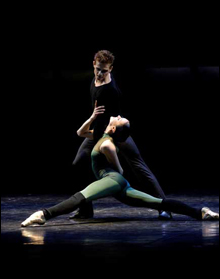
THE SEAGULL: Jealousy, creative pangs, and art that ranges from inept to mediocre. |
Boris Eifman and the Eifman Ballet of St. Petersburg have been scavenging the literature of Russian drama, novels, and ballet for 30 years now in search of suitably theatrical subjects. Anton Chekhov’s play The Seagull inspired the “spectacular new masterpiece” (their words, not mine) that came to the Cutler Majestic last week. Like all the other Eifman ballets I’ve seen, this one skims over the hard parts of its antecedent, the quicker to plug in the choreographer’s signature elements: passionate lovers with emotional problems, expert stage effects, and plenty of dancing.
The Seagull the play (1896) concerns a family of Russians with a run-down country estate and artistic aspirations. Nothing seems to happen as they talk and talk, but by the end of the play they all realize they’ve failed at their noblest intentions. We’re left to meditate on the meaning of creativity and the perils of artistic success, on vulnerability and innocence, on the sacrifices required to overturn conventions, on the price of artistic courage and of artistic complacency.
You’d think this would be very relevant to dancers today, but Eifman’s Seagull omits these subtle conflicts to expound on simpler things like jealousy — artistic and romantic. When the four characters preserved from the play aren’t lusting after one another or aiming bolts of envy at one another, they suffer terrible creative pangs and produce art that ranges from inept to mediocre.
The Seagull the ballet takes place in a traditional ballet school. A young man, Treplev (Dmitri Fisher a week ago Wednesday), begins and ends in a steel cube only a little bit bigger than he is — a symbol, I guess, of the constricting academic dance he wishes to reform. Maybe because he’s been cooped up in that tiny space, he can’t help moving with twisted, knotted limbs even when he gets a chance to choreograph.
The ballet master, Trigorin (Yuri Smelakov), is haughty and sure of himself, until Treplev’s rebellious inventions spur him to vary his classroom exercises with a few supercilious curlicues and stiff angular variations. The ballet hinges on the competition between these two men. Treplev’s mother, Arkadina (Nina Zmievets), the top ballerina in the studio, also conceited and aging, specializes in high extensions and the thinnest legs ever seen on a stage. The upstart Nina Zarechnaya (Maria Abashova) rejects Treplev’s innovations and his love to dislodge Arkadina, both as Trigorin’s mistress and as his star.
In between the duets provoked by all of this, Treplev writhes and dreams of a grand ballet about the Meaning of Life, as represented by a large pulsating white blob — all too obviously manufactured by dancers poking around inside an expanse of cloth. Later on, he dreams up an implausible crew of hip-hop dancers. Later still, the hip-hoppers and the blobs evolve in his dreams into apes or neanderthals who galumph around without a floor plan. The dancers in the corps convert gamely, sometimes skeptically, from one eccentric style to another.